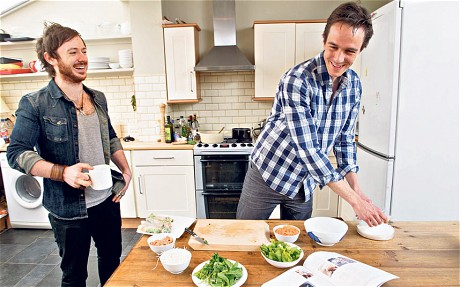Ed Henderson (2&3 South, 1999) on the day he had cook for old friend and Michelin-starred chef Ollie Dabbous (2&3 South, 1999)

‘He’ll be happy with beans on toast,” said a colleague. “It’ll just be nice for him to be cooked for,” said my wife. No one seemed to be shy of an opinion when they heard that a Michelin-starred chef was coming to sit at my eBay kitchen table for Sunday lunch. Everyone wanted to know what I was going to cook and then made no attempt to disguise their mirth when I admitted that, with fewer than seven days to go, I still had no idea.
At 32, Ollie Dabbous has made a decent enough start with his London restaurant, Dabbous, which opened last year. It has reached the stage that if a reviewer doesn’t award five stars, I assume he or she must, frankly, be wrong. The restaurant is booked more than six months in advance, and in December the Michelin star came through the post. Personally, I’d have him knighted, but I don’t think the Queen has managed to get a table yet.
We are very good friends of 25 years, since he was a tiny boy with a pudding-bowl haircut who used to win the sports day sprint races. At 18, he polished my French A-level dissertation on Camus’s L’Etranger; 10 years after that, we nearly died together many times over during a 24-hour taxi journey from Jodhpur to the Nepalese border. Now, his childhood dreams are coming to fruition and he is becoming quite well known. And I can casually name-drop him into conversations to make myself sound more interesting. Did I mention that Ollie Dabbous came to lunch on Sunday?
“Get an expensive piece of meat or fish and make sure you don’t burn it,” was the advice from my boss. Well, fish was off the menu – one of the other guests was allergic to it. (For “allergic”, I tend to read “doesn’t like”.)
A joint of meat is the default option for Sunday lunch, but I had two problems with that. One, it isn’t very imaginative, and if I were to make any kind of impression on Ollie (the other guests being of little consequence), then I needed to take him by surprise. Shock and awe had to be the tactic, not hearts and minds.
Ollie describes his food as “restrained” and “fresh”: salad of fennel, lemon balm and pickled rose petals; cucumber and borage flower in a chilled lemon verbena infusion. I knew that I should bear this in mind, but got stuck on what “restrained” really meant in the context of food. Unemotional, dispassionate?
Easy enough, I thought, I just had to casually slide the plates in front of people with an ambivalent demeanour. “Eat it if you like, I couldn’t give a monkey’s.”
“Fresh”, to my mind, said no powdered mash, no gravy granules and probably no dried herbs. But that still didn’t give me a menu. I needed a theme.
The world map on my daughter’s bedroom wall helped throw out some ideas. Spanish? No, tapas would overstretch me. Middle Eastern? No, I recently made sawdust-tasting falafel and Polyfilla-tasting hummus. Chinese? No, Chinese food is best collected from takeaways. Sweeping south over the Pacific, I came to Vietnam, a country I have travelled in, bought suits in and eaten the most wonderful fresh spring rolls in. Vietnamese food, the very embodiment of fresh and fragrant cooking, had to be the answer.
A week ago, I didn’t know who Ken Hom was. Judging by a question from one of my friends during lunch, “Is this a recipe from that Hoy bloke?”, I wasn’t the only one.
“Sir Chris?” I couldn’t resist responding. “Oh yes, this is a pre-race favourite.”
I don’t remember how Ken Hom’s Simple Asian Cookery book arrived on my kitchen shelf, but there it was, and the title couldn’t have reflected what I needed any better. There were only four Vietnamese main courses in the book, and three of them contained seafood. That left me with the simple-sounding Vietnamese-style beef stew. It sounded spot on. Spring onions, ginger, lemon grass, star anise (I didn’t know if that was a herb or a spirit), chilli, carrots, rice wine, dark and light soy sauce and a big lump of beef shin. I summarised the 12-step instructions as “throw together in a pot and apply heat”. That was the main course sorted.
One of my abiding memories of travelling in Vietnam is a lunch in the Mekong Delta eating spring rolls stuffed with various combinations of shredded beef, prawns, handfuls of mint and coriander and rice noodles, while keeping a wary eye on a python lazing nearby with a duckling-shaped bulge halfway along its body. You can eat these things (not the pythons) dipped in fish or peanut sauce, and they’re so light and fresh you don’t get tired of them. Spring rolls had to be the starter.
I didn’t open the packet of rice paper until the Sunday morning. I didn’t realise that these opaque discs with a consistency somewhere between a Communion wafer and a paper plate could be so awkward. When they were immersed in warm water, they became different and more unpleasant beasts altogether. From the first one out of the packet through to the 28th, they refused to be handled. Instead, they contorted themselves around my fingers and wrists before finally gluing themselves either to the hairs on the back of my hand or my watch strap. Rarely have I felt such fury.
On average, I managed to lay two in three flat enough on the chopping board to begin the filling procedure. Every third spring roll found its way onto the floor or my sleeve or, worst of all, attached itself to one of the successful spring rolls, necessitating delicate surgery.
Like any self-respecting chef, I had neatly arranged the fillings for the spring rolls in a flotilla of little white bowls. All I had to do was take a pinch of each ingredient and build up a delicious parcel.
What you never see on the cookery programmes is that once you have dipped fingers into each bowl two or three times, there is mass migration of ingredients resulting very soon in six bowls of identical sludge.
Ken said that the spring rolls could only be made 20 minutes before eating – any longer and they would dry out. 1240 hrs to 1300 hrs was a challenging time, not least because my young daughter decided she needed some attention, and, in a separate incident, a bottle of fish sauce was smashed on the kitchen floor. My mind shot back to when Ollie had accepted the invitation and suggested 2pm, to which I had responded that 1pm would be better. I cursed and then cursed again when the doorbell rang bang on one, and Ollie was there, having cut his lie-in short to ensure he was on time.
He politely didn’t watch as I hastily stuffed spring rolls and laid them on a plate. They were of increasingly irregular size and untidy appearance. I was so keen to get them finished before the others turned up that some were almost certainly filled with just coriander or half a prawn and nothing else.
Amid the carnage, the Vietnamese beef stew waited patiently (arguably neglected) on the hob, waiting for its turn to cause me angst. I prodded the beef to find that it had shrivelled and stiffened significantly since being slowly cooked the night before. I raised this casually with Ollie, pretending it was a general question rather than one about the lunch he was about to chew. He reassured me that the cheaper cuts of beef meant for stewing would loosen up once reheated. It did.
In the end, the whole meal went rather well. Sure, everyone had to dig out sprigs of lemon grass from the stew and make sure they didn’t choke on star anise, but nobody went hungry and nobody died.
Even the guy with the fish allergy appeared not to suffer any ill effects from eating fish sauce in the peanut dipping sauce. I had kept a watchful eye on Ollie throughout, and was delighted when he finished his plateful and announced, “You could charge for that, mate.”
Did I mention that Ollie Dabbous came for lunch the other day?
Ollie Dabbous’s guide to home cooking
- I don’t cook on my days off, so it genuinely is a pleasure to sit down with friends and be cooked for!
- Keep it simple and over-deliver.
- Have at least one course done in advance, most probably the starter or dessert, to lessen your workload.
- Don’t try to make everything perfect; it’s more important that everyone, host included, has a good time.
- People want to eat home cooking at home, not wannabe restaurant dishes.
This article first appeared in the Daily Telegraph

